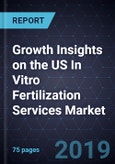Innovative Fertility-as-a-Service Business Models and the Increase in IVF being Offered as an Employment Perk, and the Rise in Egg-freezing Cycles will Accelerate Growth in the Market
Today, the journey of starting a family does not look the way it did fifty years ago, and people are turning to fertility services for help. 1 in 8 couples in the United States experience pregnancy-related difficulties that fertility treatments can address.
Key market drivers include the increasing rate of obesity causing deterred ovulation in women and low sperm quality in men; decreasing fertility of women due to physiological reasons; the preference to have children after the age of 35; and the rising number of single parents of choice and LGBTQ+ individuals or couples pursuing parenthood. In the United States, 8.1% of millennials identify as LGBTQ+ and need access to fertility coverage to build their families.
The US IVF market is fragmented and served by mostly small regional clinics. There are about 480 US fertility clinics, more than 100 sperm banks, and 1,700 reproductive endocrinologists competing in this lucrative business. Furthermore, ancillary services such as egg freezing, pre-implantation genetic testing (PGT), and surrogacy options are all leading to additional choices for patients and are driving additional market opportunity, in addition to the rise of fertility benefit companies.
Despite higher efficiency and clinical effectiveness, the high cost of IVF solutions has been one of the key market restraints, especially in the low and medium income segments. However, this is expected to change in the future, driven by new business models by the vendors, and the rise of fertility benefit companies and employers offering coverage for fertility treatment of employees.
Research Scope
The research service provides an overview of the US IVF Services Market and provides a 5-year forecast from 2018 to 2023. The total fertility market is segmented into assisted reproductive technology (ART) services and fertility medications. ART services comprise in vitro fertilization (IVF), Intracytoplasmic sperm injection (ICSI), gamete intrafallopian transfer (GIFT), and zygote intrafallopian transfer (ZIFT). IVF contributes 95% to 99% of total ART services. In this report, the researchers have focused on the services supporting the IVF process. The geographic scope of this study is the United States.
The study highlights key drivers and restraints in the market, regulatory and reimbursement landscape, current market dynamics, visioning scenarios, and key growth opportunities, such as Pre-implantation Genetic Testing (PGT), AI-based detection of viable embryos for IVF, Oocyte Cryopreservation/Elective Egg Freezing Services and Three-Parent IVF/Mitochondrial Replacement Therapy (MRT). Further, the study includes a competitive landscape, in addition to key companies to watch, innovative business models/use cases in the market, and the strategic imperatives for the IVF services industry.
Key Issues Addressed
- How has the market attractiveness of IVF services grown over the years?
- What is the future market potential?
- Which are the disruptions that affect the value chain equilibrium?
- How new technology trends are impacting service providers?
- Which are the game-changing companies at work?
- What are the strategic levers that will help market participants to stay on the growth trajectory?
- What are the gaps in the market that provide opportunities to new entrants and encourage penetration?
- What are the latest IVF service, business models?
- What should market participants do to stay competitive? What are the go-to-customer models and innovation in customer segmentation that the reader can expect?
Table of Contents
Companies Mentioned (Partial List)
A selection of companies mentioned in this report includes, but is not limited to:
- Genomic Prediction
- Glow, Inc
- Life Whisperer
- Progyny, Inc








